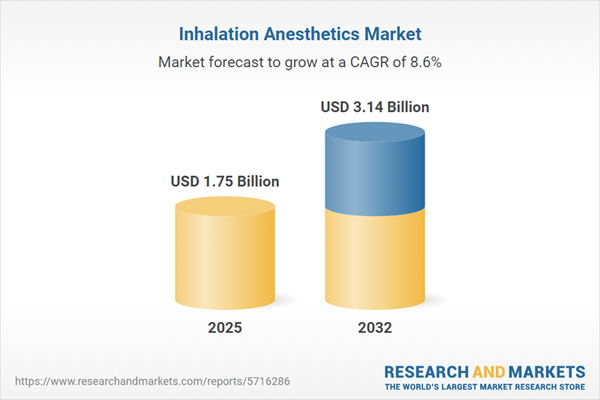Speak directly to the analyst to clarify any post sales queries you may have.
The inhalation anesthetics market is undergoing significant transformation amid evolving clinical expectations, shifting regulatory frameworks, and growing sustainability priorities. For senior executives, actionable insight into this dynamic sector is crucial for navigating operational complexity and informing resilient procurement strategies.
Market Snapshot: Inhalation Anesthetics Market Size and Growth
In 2024, the inhalation anesthetics market reached USD 1.62 billion, with strong momentum projected to elevate it to USD 1.75 billion by 2025 and USD 3.14 billion by 2032. This represents a compound annual growth rate (CAGR) of 8.63%. Expansion in this sector is driven by the adoption of advanced anesthetic technologies, streamlined procurement processes, and enhanced workflow management systems. Healthcare providers are focusing on supply chain agility and efficiency to adapt to evolving care standards and optimize spending, while aiming to deliver improved patient experiences across integrated hospital settings.
Scope & Segmentation of the Inhalation Anesthetics Market
This report provides senior executives with actionable intelligence, detailing the critical market dimensions and operational nuances impacting procurement, investment initiative alignment, and strategic decision-making. Segmentation reflects the primary factors influencing both supply and demand:
- Product Types: Includes Desflurane, Enflurane, Halothane, Isoflurane, and Sevoflurane, all with proven safety profiles and established utility in numerous surgical environments and clinical contexts.
- Age Groups: Protocols are configurable for adult, pediatric, and geriatric patients, supporting consistent care and optimized clinical outcomes for each group.
- Applications: Induction and maintenance phases in anesthesia are both addressed, enabling streamlined perioperative workflows and high standards of reliability in acute situations.
- End Users: Hospitals, intensive care units, ambulatory and specialty clinics, military healthcare operations, and veterinary providers each have tailored procurement needs and support models to match operational workflows.
- Distribution Channels: Dual-channel availability—online and offline—bolsters supply chain continuity, giving organizations rapid flexibility in response to fluctuating case volumes or shifting regional demands.
- Regions: The Americas, Europe, Middle East & Africa, and Asia-Pacific feature unique market forces and collaboration models, influenced by infrastructure maturity and regulatory compliance standards.
- Key Companies: Companies such as Baxter International Inc., Halocarbon Life Sciences, AbbVie Inc., Piramal Enterprises Limited, and Fresenius Kabi AG are leading innovation and ensuring consistent supply across markets.
Key Takeaways for Inhalation Anesthetics Market Leaders
- Recent formulation developments enhance clinical consistency and support more robust risk management, increasing confidence across care teams.
- New technologies like smart vaporizers and AI-assisted dosing systems are helping optimize perioperative accuracy and resource deployment, shaping future operational models.
- Growing regulatory emphasis on environmental sustainability is encouraging adoption of eco-friendly procurement practices and revised equipment standards to meet evolving compliance needs.
- The integration of digital health platforms and clinical informatics, including applications in genomics, is driving anesthesia delivery toward personalized protocols for specialized procedures, unlocking new efficiency gains.
- Collaboration initiatives, especially across Asia-Pacific, are encouraging the uptake of advanced solutions and partnerships between health systems and suppliers, contributing to wider market adaptability.
- Expanded cooperation between manufacturers and device vendors is increasing the agility and resilience of anesthetic supply chains, promoting an adaptive response to emergent regulations and operational shifts.
Tariff Impact: United States Tariff Measures in 2025
Impending changes to United States tariff measures are prompting healthcare organizations to revisit their supply chain frameworks. Executive teams are deploying analytics and ramping up regional collaborations to safeguard procurement reliability, contain operating costs, and remain agile in a shifting regulatory environment.
Methodology & Data Sources
This market research is grounded in direct interviews with industry experts and quantitative analysis. Supplemental insights from peer-reviewed and validated sources ensure all findings are both credible and actionable for decision-makers planning investments or procurement initiatives.
Why This Report Matters
- Enables benchmarking of operational practices and supports the acceleration of procurement and digital transformation, aligning with high-level institutional goals.
- Offers data-driven guidance, allowing leaders to successfully respond to advances in anesthesia technology, shifting regulations, and new workflow demands.
- Strengthens segmentation and risk mitigation, which contributes to ongoing organizational resilience and sustained performance amid market change.
Conclusion
In the evolving landscape of inhalation anesthetics, adaptable strategies and a commitment to innovation are key to maintaining enterprise stability. Forward-thinking executives who align priorities with emerging operational and regulatory realities are best positioned for sustained growth.
Additional Product Information:
- Purchase of this report includes 1 year online access with quarterly updates.
- This report can be updated on request. Please contact our Customer Experience team using the Ask a Question widget on our website.
Table of Contents
3. Executive Summary
4. Market Overview
7. Cumulative Impact of Artificial Intelligence 2025
Companies Mentioned
The companies profiled in this Inhalation Anesthetics market report include:- Baxter International Inc.
- Halocarbon Life Sciences
- Lunan Pharmaceutical Group Co. Ltd.
- AbbVie Inc.
- Piramal Enterprises Limited
- Fresenius Kabi AG
- Hikma Pharmaceuticals PLC
- Troikaa Pharmaceuticals Ltd.
- Maruishi Pharmaceutical Co., Ltd.
- Pfizer Inc.
- Jiangsu Hengrui Medicine Co., Ltd.
- Yichang Humanwell Pharmaceutical Co., Ltd.
- Zoetis Inc.
- Draegerwerk AG & Co. KGaA
- Linde PLC
- Dechra Pharmaceuticals PLC
- Halocarbon Products Corporation
- RAMAN WEIL
- Piramal Critical Care Limited
- Aetos Pharma Private Limited
- NextSource Pharma
- Dechra Veterinary Products
Table Information
| Report Attribute | Details |
|---|---|
| No. of Pages | 193 |
| Published | November 2025 |
| Forecast Period | 2025 - 2032 |
| Estimated Market Value ( USD | $ 1.75 Billion |
| Forecasted Market Value ( USD | $ 3.14 Billion |
| Compound Annual Growth Rate | 8.6% |
| Regions Covered | Global |
| No. of Companies Mentioned | 23 |









